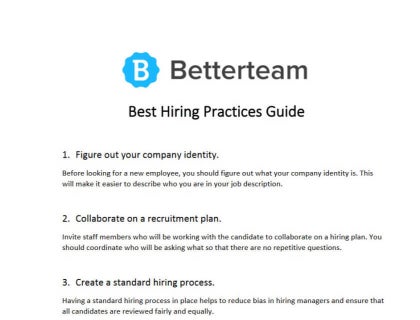
Best Hiring Practices:
1. Figure out your company identity.
Before looking for a new employee, you should figure out what your company identity is. This will make it easier to describe who you are in your job description. A company's culture and ethos influence whether a candidate applies for a position, so this is an important step.
2. Create a standard hiring process.
Having a standard hiring process in place helps to reduce bias in hiring managers and ensure that all candidates are reviewed fairly and equally. Invite staff members who will be working with the candidate to collaborate on a hiring plan. Each interviewer should be given an opportunity to question the candidate and provide feedback to the team.
3. Tailor the hiring process to the size and structure of your business.
Startups will need candidates who are multi-talented and eager to get involved in several aspects of the business. These companies will often only have a few team members, so the successful candidate should be aware of this.
For a larger business, you should be looking for candidates with specific skills and experience. It is unlikely that the candidate will need to perform more than one role.
4. Create realistic job requirements.
Many advanced job boards offer screening services that parse resumes based on how well they meet a job's criteria. Most people won't meet all the requirements if they are not created realistically. Even if automated screening isn't in place, people may be reluctant to apply if the requirements don't justify the salary offered or the experience needed.
5. Look for candidates within your company.
Most new appointments come from external applications rather than internal ones. This is largely due to the fact that many new applicants are more qualified for the role, and it may be easier to hire them than train an existing employee. Your current staff may become unsatisfied with their career progression and thus choose to work elsewhere.
6. Ask for referrals.
A good way to find trustworthy and competent candidates is to ask employees to refer people. You could offer an incentive for doing so to encourage more employees to participate.
7. Limit the number of applicants.
It takes time and money to filter through applicants, interview them, and train the right person. You can reduce the number of initial applicants by stating nonnegotiable requirements as well as the skills and traits that you would prefer. Sending out screening questions to applicants can also dramatically reduce the pool of candidates early on.
8. Take the time to get to know the candidate.
On average, the hiring process takes about 24 days. More time is being put into the hiring process so that employers can learn enough about the candidate to make a relatively safe hiring choice.
It is advisable that hiring managers hold multiple interviews. Department heads should be invited to participate in these interviews since they will be working with the successful candidate(s). Remember to account for their opinions about candidates when making the final selection.
9. Keep candidates informed.
Let candidates know what your hiring process's timeline is as well as what the next steps are. This will keep candidates informed and interested. Many businesses only respond to applicants if they are interested in an interview, but it will give your company a positive reputation if you take the time to let a candidate know that you will not be moving their application to the next stage.

